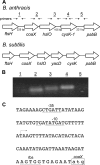The type III pantothenate kinase encoded by coaX is essential for growth of Bacillus anthracis
- PMID: 18641144
- PMCID: PMC2546792
- DOI: 10.1128/JB.00860-08
The type III pantothenate kinase encoded by coaX is essential for growth of Bacillus anthracis
Abstract
In Bacillus anthracis, the novel type III pantothenate kinase (PanK(Ba); encoded by coaX) catalyzes the first committed step in coenzyme A biosynthesis. We have demonstrated by analyzing the growth characteristics of a conditional coaX mutant that PanK(Ba) is an essential enzyme, thus contributing to its validation as a new antimicrobial target.
Figures




Similar articles
-
Probing the ligand preferences of the three types of bacterial pantothenate kinase.Bioorg Med Chem. 2018 Dec 1;26(22):5896-5902. doi: 10.1016/j.bmc.2018.10.042. Epub 2018 Nov 2. Bioorg Med Chem. 2018. PMID: 30429095
-
Essentiality and functional analysis of type I and type III pantothenate kinases of Mycobacterium tuberculosis.Microbiology (Reading). 2010 Sep;156(Pt 9):2691-2701. doi: 10.1099/mic.0.040717-0. Epub 2010 Jun 24. Microbiology (Reading). 2010. PMID: 20576686
-
Structure of the type III pantothenate kinase from Bacillus anthracis at 2.0 A resolution: implications for coenzyme A-dependent redox biology.Biochemistry. 2007 Mar 20;46(11):3234-45. doi: 10.1021/bi062299p. Epub 2007 Feb 27. Biochemistry. 2007. PMID: 17323930 Free PMC article.
-
Crystal structure of a type III pantothenate kinase: insight into the mechanism of an essential coenzyme A biosynthetic enzyme universally distributed in bacteria.J Bacteriol. 2006 Aug;188(15):5532-40. doi: 10.1128/JB.00469-06. J Bacteriol. 2006. PMID: 16855243 Free PMC article.
-
Physiological roles of the pantothenate kinases.Biochem Soc Trans. 2014 Aug;42(4):1033-6. doi: 10.1042/BST20140096. Biochem Soc Trans. 2014. PMID: 25109998 Free PMC article. Review.
Cited by
-
Random Mutagenesis Applied to Reveal Factors Involved in Oxidative Tolerance and Biofilm Formation in Foodborne Cronobacter malonaticus.Front Microbiol. 2019 May 1;10:877. doi: 10.3389/fmicb.2019.00877. eCollection 2019. Front Microbiol. 2019. PMID: 31118922 Free PMC article.
-
Antimicrobial activity of pantothenol against staphylococci possessing a prokaryotic type II pantothenate kinase.Microbes Environ. 2014;29(2):224-6. doi: 10.1264/jsme2.me13178. Epub 2014 Apr 22. Microbes Environ. 2014. PMID: 24759689 Free PMC article.
-
Identification of a depupylation regulator for an essential enzyme in Mycobacterium tuberculosis.Proc Natl Acad Sci U S A. 2024 Dec 3;121(49):e2407239121. doi: 10.1073/pnas.2407239121. Epub 2024 Nov 25. Proc Natl Acad Sci U S A. 2024. PMID: 39585979 Free PMC article.
-
The coenzyme A disulphide reductase of Borrelia burgdorferi is important for rapid growth throughout the enzootic cycle and essential for infection of the mammalian host.Mol Microbiol. 2011 Nov;82(3):679-97. doi: 10.1111/j.1365-2958.2011.07845.x. Epub 2011 Oct 12. Mol Microbiol. 2011. PMID: 21923763 Free PMC article.
-
Characterization of the N-acetyl-α-D-glucosaminyl l-malate synthase and deacetylase functions for bacillithiol biosynthesis in Bacillus anthracis.Biochemistry. 2010 Sep 28;49(38):8398-414. doi: 10.1021/bi100698n. Biochemistry. 2010. PMID: 20799687 Free PMC article.
References
-
- Altschul, S. F., W. Gish, W. Miller, E. W. Myers, and D. J. Lipman. 1990. Basic local alignment search tool. J. Mol. Biol. 215403-410. - PubMed
-
- Antelmann, H., R. C. Williams, M. Miethke, A. Wipat, D. Albrecht, C. R. Harwood, and M. Hecker. 2005. The extracellular and cytoplasmic proteomes of the non-virulent Bacillus anthracis strain UM23C1-2. Proteomics 53684-3695. - PubMed
Publication types
MeSH terms
Substances
Grants and funding
LinkOut - more resources
Full Text Sources
Molecular Biology Databases

